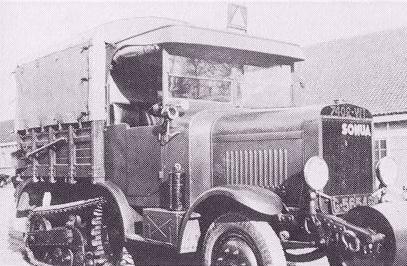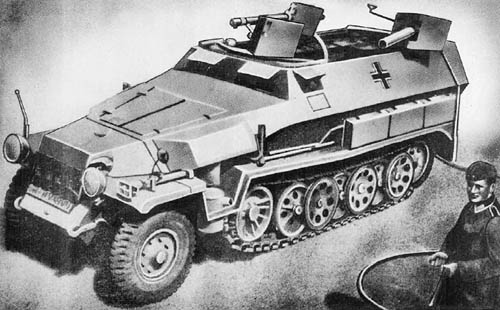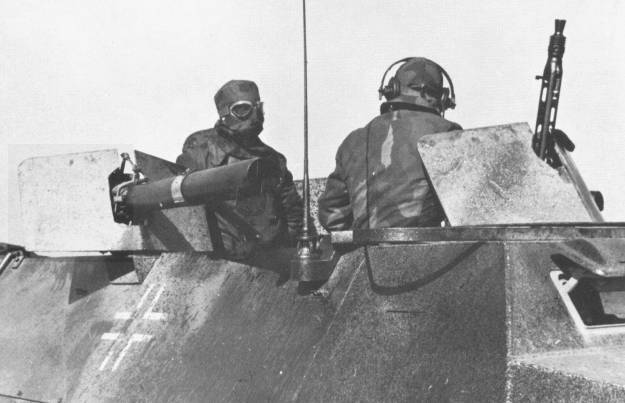I was thinking that maybe an ability to fire one round and watch for fall then let loose with the rest ‘suitable adjusted’ may have made it a bit more useful.
That then really depends also on the type of munitions and blast radius they have as to whether it is necessary, with a range of 2.7km maybe it was used to just kill an area.
Interestingly it seems to have a sighting system fitted to the rear of the tubes so maybe that is a good enough targeting mechanism for this weapon.
It possible that kind of employment be more useful, but if you want to fire just one and then correct is for more prectical to had simply a mortar carring armored vehicle attached to the infantry platoon, the multiple tube requeriment was crucial because a large salvo was needed.
This vehicle was also intended to be employed in a well known area, area in wich the topographic adjustments for an artillery piece were already known.
The number of this model were 36, also some 20 units of the “heavy” mortar launcher were converted.

The “base” halftrack was an artillery tractor, look like this. Not the best looking but still a solid, reliable machine.

Many Thanks Panzerknacker my friend.
Years ago I was hurriedly reading an article on these. Felt I may have mis-recalled the number converted.
Kind and Respectful Regards my friend Panzerknacker, Uyraell.
No problem mate:
MIttlerer Flampanzerwagen Sd. Kfz 521/16.

The medium sized flamethrower was based on a well know Sd.Kfz 251 halftrack and made on request of Eastern front commanders. The Flammpanzerwagen was to be used in bush or closed country to attack enemy infantry in wooden bunkers, trenches or to burn down houses and buildings in the urban combat.
This special panzer gave a considerable boost to the firepower in the infantry zug ( platoon) but given the short range of the flame launcher made it was vulnerable to antitank rifle fire and relegated actions in open country to night ot low light hours.

Its device consisted in a 30 hp two stroke engine to pump the “flammöl” burning fuel ( a mixture of low octane gasoline and mineral oil). There were two flamethorwers , one with a 14mm diameter muzzle and a range of 50 meters. And other with a 7mm diameter muzzle and a range of 40 meters. Firing the two pipes at the same time was nor recomended since it downsized the range of each muzzle.
Is not precisely know how many of this incendiary variant haltrack were made but is stimated in 1000 to 1200 all completed the firm Wesserhütte.
Sd.Kfz 251 / 16:
Engine : Maybach 6 cilinders 100 hp
Armor: 14, 5mm to 8mm
Armament: 2 flamethrowers, 2 MP 40 with 392 rounds, 1 MG 34 or MG 42 with 2100 rounds. 20 stick hand grenades.
Speed: 50 km/h
Weight: 8650 kg.

Note “special” protection clothing of the 251/16 crews:

That definately gave them a modern soldier looking, remember me the protective clothing used by the uS army in the 1991 desert Storm .

The open top configuration looks like a sniper’s wet-dream though…
Indeed but the schutzenpanzerwagen was a good improvement over the classical transport of teh infantry, his feet.
[FONT=Verdana]Selbstfahrlafette für 28/32 cm Wurfrahamen auf Infanterieschlepper UE[/FONT]
[FONT=Verdana][/FONT]
[FONT=Verdana]Quite long name for a really small vehicle. Using the large amount of UE this movable projectiles launchers is based on the light UE armoured chassis and it had a very specific function, to deliver a burst of hevy rockets over an allied beachhead once they reached any part of the French northern coast.[/FONT]
[FONT=Verdana] [/FONT]
[FONT=Verdana]The “wurfrahamen”, launching frame was light and very simple structure and could be adjusted for elevation for but have no azimuth at all. The rockets were to be aimed turning the entire vehicle. The heavy german artillery rockets were spin-stabilized with a range of 1800 meters (280mm variant) and 2000 meters ( 320 mm variant), once they landed on its target the effective explosive radius was stimated in 50 meters.[/FONT]
[FONT=Verdana][/FONT]
[FONT=Verdana][/FONT]
[FONT=Verdana] [/FONT]
[FONT=Verdana]In any case it wasnt spected to use this tiny panzer in first line, his function was to deliver an salvo of rockets and quickly retire to cover/ reload in a safe area.[/FONT]
[FONT=Verdana] [/FONT]
[FONT=Verdana][SIZE=2]Between 40-50 of this small special panzer were in service in the years 1943-44.[/SIZE][/FONT]

Gepanzerter-Munitions Zugkraftwagen MCG
Armored munition carrier. A tipical german rebuild vehicle, based on the trusty Somua 5 ton halftrack. The chassis and cabin were fully covered with 8mm chrome-moly steel plate. A total of 48 build in 1943 and used to support the 75 mm pak self propelled tank-hunters of the panzer-sturmbrigade 200 operating in the defensive front of the Atlantic Wall, north of France.


Weight of the entire panzer was about 8,8 tons
